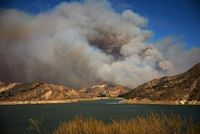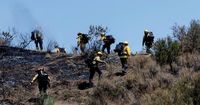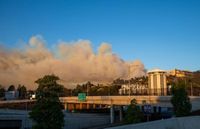As Southern California sweltered under a heatwave in early August 2025, the region was thrust into crisis mode when the Canyon Fire erupted on August 7. Igniting in a remote area east of Lake Piru, north of Highway 126 and west of Castaic in Ventura County, the wildfire quickly became a major threat, putting thousands of residents and homes in Ventura and Los Angeles counties on high alert. By the afternoon of August 9, the fire had scorched more than 5,370 acres and was 48% contained, according to CalFire. The rapid spread and sheer scale of the blaze forced emergency officials to issue, and then later downgrade, evacuation orders for tens of thousands of people.
For many, the nightmare began Thursday afternoon, as flames raced through dry brush and mountainous terrain near Holster Canyon. Within hours, the fire ballooned to over 1,500 acres, catching residents and authorities off guard. By Friday morning, it had grown to 4,756 acres with zero containment, and by Saturday afternoon, it had reached 5,370 acres. The fire’s eastward movement toward the community of Castaic in Los Angeles County kept nerves frayed and officials on edge. As the Los Angeles County Fire Department reported, “Crews worked throughout the night to improve defensive positions and further secure the fire’s perimeter. Overnight fire activity was minimal as firefighters worked to continue strengthening existing control lines.”
Mandatory evacuation orders initially affected approximately 5,000 people, with warnings for another 11,000, as stated by FEMA. At the height of the crisis, the fire was threatening about 5,118 homes in and around Hasley Canyon and Val Verde. “This afternoon, we’re starting to see the temperatures come back up, we’re seeing winds start to pick up,” Andrew Dowd with Ventura County Fire told KABC-TV. “There’s still a risk here. Fire is still burning, and we’re still going to be incredibly vigilant until we get this fire contained.”
Remarkably, by Friday evening, evacuation orders for thousands of Southern California residents were lifted and downgraded to evacuation warnings, allowing people to return home but with a stern caution to remain ready to leave at a moment’s notice. The shift from orders to warnings reflected both the tireless efforts of over 1,100 firefighters—supported by 45 engines, seven helicopters, three dozers, and nine hand crews—and a bit of luck with favorable weather conditions. Ventura County officials noted, “Firefighters were making good progress in suppressing the blaze, aided by favorable weather conditions and the continued use of firefighting aircraft making repeated water and retardant drops to slow the fire’s advance and support crews on the ground.”
Yet, the threat was far from over. The fire continued to burn actively, especially in challenging mountainous terrain, and officials emphasized that conditions could change rapidly. Residents in affected areas were urged to stay alert, keep emergency supplies at the ready, and monitor official updates closely. As one Castaic resident, Geri Aebersold, told KABC-TV, “It’s been a long night just watching the fire. Just watching it coming up right there on that hill. A firefighter said, ‘You’re ok. We got this.’”
While no civilian injuries or destroyed structures were reported, the cost of fighting the fire was not without its toll. Three firefighters suffered minor injuries and were taken to a local hospital as a precaution, but all were expected to recover. Another firefighter was injured in a rollover crash in Romero Canyon and was airlifted to a hospital but remained alert. The dangerous conditions highlighted the perils first responders face during wildfire season, with every deployment carrying significant risks.
As the flames raged, a new threat emerged: hazardous air quality. The South Coast Air Quality Management District issued an air quality alert on Friday night, affecting vast swaths of Southern California, including the Santa Clarita Valley, San Fernando and San Gabriel valleys, and the Inland Empire. The alert, which expired Sunday morning for the Santa Clarita Valley and Saturday night for other areas, was prompted by smoke from the Canyon Fire and other wildfires, which blanketed the region in a haze of fine particle pollution. The National Weather Service warned that “particles in wildfire smoke can get deep into the lungs and cause serious health problems such as heart attacks, strokes, asthma attacks, and difficulty breathing.”
People with lung or heart disease, older adults, pregnant women, children, and those who spend significant time outdoors were identified as especially vulnerable. The NWS and AQMD advised residents to “remain indoors with windows and doors closed,” “avoid intense outdoor physical activity,” and use air conditioning or air purifiers if possible. For those who had to venture outside, a well-fitting N-95 mask was recommended. The AQMD also urged people to avoid other sources of pollution, such as fireplaces, candles, grilling, and gasoline-powered garden equipment, to minimize compounding the already poor air quality.
AccuWeather meteorologist Brandon Buckingham explained to Newsweek that “ozone is a secondary pollutant, meaning it’s not emitted directly from sources, but is formed through chemical reactions. These reactions require sunlight and higher temperatures, making warmer months more prone to ozone formation. When air is stagnant, pollutants don’t get dispersed, allowing ozone to build up to unhealthy levels.”
The air quality alerts and health advisories underscored the broader public health risk posed by wildfires, extending well beyond the immediate threat of flames. Wildfire smoke contains tiny particles—less than 2.5 micrometers in diameter, about 4% the width of a human hair—that can penetrate deep into lung tissue and exacerbate or trigger chronic conditions, including asthma, lung cancer, and heart disease. For thousands of Southern Californians, the advice was clear: stay indoors, monitor the Air Quality Index, and take all precautions seriously.
The Canyon Fire was not the only blaze taxing California’s emergency resources. The Gifford Fire, which started August 1 in Los Padres National Forest, had already consumed more than 110,000 acres and was only 21% contained, according to CalFire. This pattern of large, fast-moving wildfires has become all too familiar in recent years, fueled by historically dry vegetation, high temperatures in the mid-90s Fahrenheit, low relative humidity (19-24%), and wind gusts up to 20 mph.
Federal resources were quickly mobilized. On August 8, FEMA authorized the use of federal funds to help California battle the Canyon Fire, providing up to 75% of eligible firefighting costs. The state had sought federal assistance as soon as it became clear how rapidly the fire was spreading and the scale of the threat to life and property.
As of Sunday, August 10, 2025, the situation remained fluid. While the lifting of evacuation orders brought relief, officials continued to stress vigilance. With containment lines holding but the fire still active, the message was unmistakable: stay prepared, heed air quality warnings, and trust the dedicated crews who continue to defend lives and homes from the ever-present danger of wildfire.
For Southern California, the events of August 2025 serve as a stark reminder of the region’s vulnerability to wildfire, the heroism of first responders, and the importance of community resilience in the face of nature’s fury.


